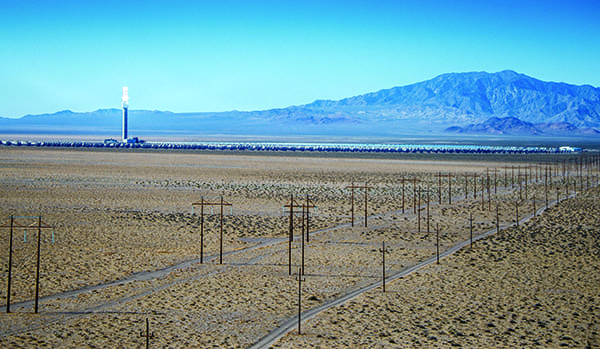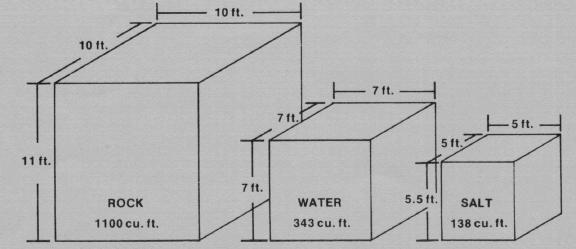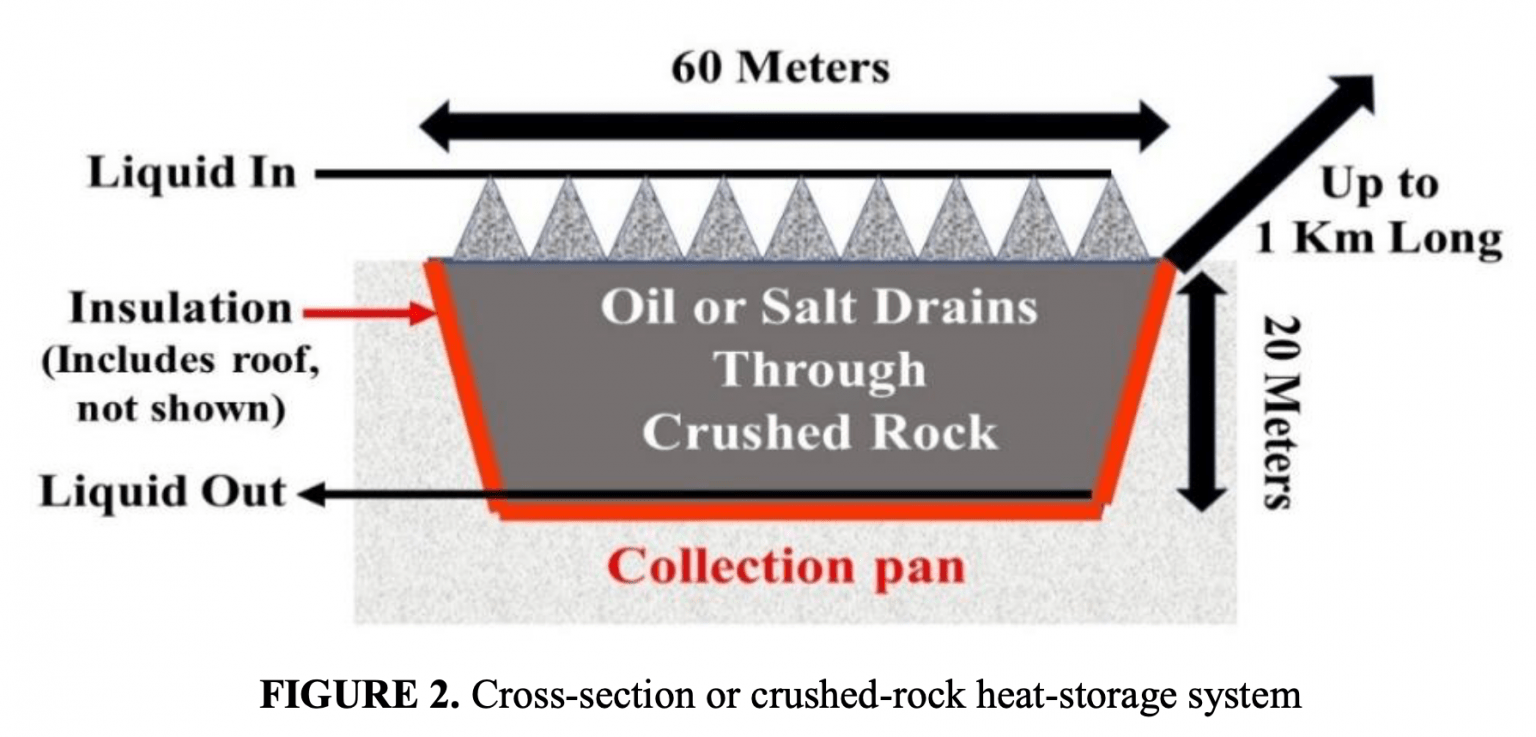New Mars Forums
You are not logged in.
- Topics: Active | Unanswered
Announcement
#26 2021-11-30 11:16:54
- Calliban
- Member
- From: Northern England, UK
- Registered: 2019-08-18
- Posts: 4,269
Re: Thermal Energy Storage
For SpaceNut re #24
Your post gave me pause ..... I'm back with a couple of observations and a request of kbd512 ...
The size of a molten silicon storage device is not at all clear. Is there a reason why it has to be larger than the devices you showed in post #24?
I can't see a reason, but perhaps you can.
Observation 1: Vacuum is an excellent insulator.
Observation 2: Radiation from a hot body is described as "black body" radiation ....
Speculation: a mass of molten silicon in a container capable of holding it would produce black body radiation at a steadily decreasing rate.
If the mass were held in a cavity able to hold vacuum, and if the inside walls of the cavity were lined with photoelectric receptors tuned to a wide range of spectrum (multiple layers?) then I would ** assume ** the thermal energy of the mass, converted to photons, would yield a current flow.
How large that current flow might be is something that a member might be able to estimate.
Unknowns that I'm aware of:
1) Material to hold molten silicon
2) Method of supporting container of molten silicon inside vacuum cavity
3) Selection of photoelectric receptors to cover black body radiation (as much as possible)
4) Method of managing heat generated in the wall of the container due to failed receptionI'm wondering if a quart of molten silicon might yield a 15 AMP flow at 120 VAC for an hour.
That would be a consumer product, and there is a very large market for such a device.
The silicon mass would be heated by simple resistance heating from a utility power source.
This concept would (presumably) be infinitely re-usable, with a lifetime for components measured in decades.
(th)
The key problems with high-temperature TES as a mechanical power source at small scale:
1. Thermal leakage. Heat loss is a function of surface area and differential temperature. The smaller the thermal store is, the greater the ratio of surface area to volume.
2. Insulation thickness. For a thermal reservoir with a temperature of 1400°C insulation must be thick enough to limit thermal leakage and keep surface temperature low enough to be safe.
3. Smaller heat engines are less efficient due to irreversibilities in thermodynamic processes. That is one of the reasons we tend not to see micro steam engines powering individual tools.
It is precisely because of the thermal leakage problem that molten silicon is difficult to use in small scale applications. It is why Kbd512 felt confident examining its use for a train but not a car.
However, I believe a variation on the concept could meet your requirements. 15amp @120V-AC for 1 hour is 1.27kWh, which is just shy of 5MJ. You could store this energy using two phase change materials, one being brine with a melting point of -70°C, say, and the other being a phase change material with a melting point of 100°C. A heat pump could charge the battery by pumping energy out of the cold store and into the hot store. A heat engine would recover power by reversing the process.
Aqueous phase change materials are extremely cheap. The medium that contains them is also extremely cheap, an insulated tank. The heat pump and generator are relatively expensive. However, I suspect that reversible TES may be an excellent choice for home energy storage.
Last edited by Calliban (2021-11-30 11:43:51)
"Plan and prepare for every possibility, and you will never act. It is nobler to have courage as we stumble into half the things we fear than to analyse every possible obstacle and begin nothing. Great things are achieved by embracing great dangers."
Offline
Like button can go here
#27 2021-11-30 11:29:31
- tahanson43206
- Moderator
- Registered: 2018-04-27
- Posts: 23,415
Re: Thermal Energy Storage
For Calliban re #26 ...
Thank you for another insightful contribution to the topic.
however, in the case of #25, I was NOT talking about mechanical systems in any way, shape or form.
The post was specifically about capturing black body radiation from the hot mass.
The device would have NO moving parts (except electrons).
If you have time, please think about a system that does NOT involve mechanical activity of any kind.
(th)
Offline
Like button can go here
#28 2021-11-30 18:50:02
- SpaceNut
- Administrator
- From: New Hampshire
- Registered: 2004-07-22
- Posts: 29,894
Re: Thermal Energy Storage
kbd512
Molten Silicon: 528Wh/kg and 4.3MJ/L @ 1414C
Calliban
15amp @120V-AC for 1 hour is 1.27kWh, which is just shy of 5MJ.
AC single phase watts to amps calculation formula
The phase current I in amps (A) is equal to the real power P in watts (W), divided by the power factor PF times the RMS voltage V in volts (V):
I(A) = P(W) / (PF × V(V) )
or
(PF × V) A = W
(120 v x 0.8 ) 15 amp = 1440 watts
if voltage is low
(100 v x 0.8) 15 amp = 1200 watts
1440 w / 528 W/kg = 2.727 kg
1200 w / 528 w/kg = 2.272 kg
of course that does not account for cooling rate as a function of power conversion media working fluid, losses due to plumbing, pumps, cold storage thermal syphon.
Offline
Like button can go here
#29 2021-11-30 21:27:52
- tahanson43206
- Moderator
- Registered: 2018-04-27
- Posts: 23,415
Re: Thermal Energy Storage
For SpaceNut re #28
Thank you for a ** very ** nice follow up!
3 kg is 6.61 pounds .... That seems like an amount that could fit in a power wagon about the size of a kid's wagon, or perhaps a bit larger.
I'm reminded of a point that Calliban made, long ago and far away in the archive, about the poor thermal conductivity of rock. If the hot silicon is inside a vessel able to withstand 1414C, and if that vessel is supported on a stone column and secured by a similar stone column at the top, then it should be able to radiate to the photoelectric receptors around the inside of the vacuum chamber.
I noticed you included power conversion fluid, plumbing, pumps and ? a cold storage thermal syphon?
None of those would be needed in a solid state energy storage device such as I described above.
(th)
Offline
Like button can go here
#30 2021-11-30 22:06:36
- SpaceNut
- Administrator
- From: New Hampshire
- Registered: 2004-07-22
- Posts: 29,894
Re: Thermal Energy Storage
https://www.pv-magazine.com/2018/12/07/ … -says-mit/
https://www.engineersaustralia.org.au/N … en-silicon
https://www.solarpaces.org/mit-proposes … l-storage/
The technology uses two large 10-meter wide graphite tanks, which are heavily insulated and filled with liquid silicon. One tank stores silicon at a temperature of 1926°C. The “cold” tank is connected via a bank of tubes and heating elements to a “hot” tank in which liquid silicon at a temperature of 2370°C is stored.
When electricity is needed, the molten white-glowing liquid silicon is pumped through an array of tubes that emit light.
The tubes are routed past high-efficiency solar cells, called multi-junction photovoltaics, with the light from the molten silicon then being turned back into electricity.
Through that process the silicon cools down and flows back into the “cold” tank, to be used again.
No light for the high temp PV cells to make power if the molten silicon is not pumped...
Offline
Like button can go here
#31 2021-12-01 04:23:58
- Calliban
- Member
- From: Northern England, UK
- Registered: 2019-08-18
- Posts: 4,269
Re: Thermal Energy Storage
How do you pump a liquid that has temperature 2370°C? There aren't many materials that are solid at those temperatures. I can only see this having a chance of working if the silicon remains stationary.
Last edited by Calliban (2021-12-01 04:26:12)
"Plan and prepare for every possibility, and you will never act. It is nobler to have courage as we stumble into half the things we fear than to analyse every possible obstacle and begin nothing. Great things are achieved by embracing great dangers."
Offline
Like button can go here
#32 2021-12-01 08:19:43
- tahanson43206
- Moderator
- Registered: 2018-04-27
- Posts: 23,415
Re: Thermal Energy Storage
For Calliban re #31
Aside from the other interesting aspects of the current discussion, I think your question in Post #31 is particularly interesting.
A quick check with Google gave this:
What material can withstand 3000 degrees?
In the aircraft applications for carbon-carbon materials, both the reinforcing fibers and the binder are made of carbon, which is how the name carbon-carbon composites arose. Carbon's high melting point is responsible for the material's ability to withstand temperatures close to 3,000 degrees.
BUSINESS TECHNOLOGY; Withstanding 3000-Degree Heat
www.nytimes.com › 1988/11/23 › business-technology-withstanding-3000...
About Featured Snippets
My assumption in seeing that snippet, is that perhaps sustained operation at those temperatures may have been (may be) encountered by the U2 class of aircraft. But then, the question of how to transport (or even to just ** hold **) liquid silicon is intriguing.
If we are lucky, SpaceNut will be back with answers!
(th)
Offline
Like button can go here
#33 2021-12-01 09:25:20
- tahanson43206
- Moderator
- Registered: 2018-04-27
- Posts: 23,415
Re: Thermal Energy Storage
I could be wrong, but I ** think ** I am seeing signs of potential value showing up in this topic....
The premise is that it is reasonable and practical to consider using simple thermal energy as a commodity that can be stored and retrieved as needed.
There are some restrictions on the "technology".... this is surely one of the most primitive ever discovered by humans.
Long ago campers discovered that heating rocks in a wood fire is a way of storing thermal energy that can be "retrieved" slowly over a long, cold night, by piling plenty of soil over the hot rocks before bedding down.
We have seen (in this topic and elsewhere) descriptions of large scale thermal energy stores for industrial scale applications.
In recent days, we've begun to explore the practicality of thermal energy stores for a modest application, such as providing work site power for an hour or so.
SpaceNut originally offered the opinion that it may not be possible to package thermal energy store in a small volume at an acceptable mass, but then he and Calliban seem to have refined the vision a bit.
We have not yet worked out how thermal energy can be retrieved in a useful form (ie, electricity).
We've seen a complex method on offer, with pumps and exotic materials for movement of molten silicon.
I'm hoping we can arrive at a solution that allows thermal energy to be drawn off from a store in the form of electron flows, without any mechanical subsystems at all.
We'll need to ** really stretch ** our collective imagination to pull this off, because (obviously) no one on Earth has done so, so the challenge must be extraordinarily difficult.
It may even be impossible. There may well be a reason why we don't see such systems for sale at the local tool supply.
(th)
Offline
Like button can go here
#34 2021-12-01 11:54:12
- kbd512
- Administrator
- Registered: 2015-01-02
- Posts: 8,349
Re: Thermal Energy Storage
SpaceNut,
No light for the high temp PV cells to make power if the molten silicon is not pumped...
The molten Silicon (applies to every material, though, not just Silicon- every bit of matter above absolute zero is always emitting photons at various wavelengths) can be used to convert photonic power into electrical power by striking photovoltaic cells, not through a temperature delta associated with being pumped from one tank to the next (in pure thermal systems temperature deltas are also associated with pressure changes, which produce mechanical power output when used to push a piston or spin a turbine). If they're combining thermal power generation (using a high temperature gas turbine) with TPV cells, or if it's purely thermal power transfer to a working fluid like CO2, then you need "hot" and "cold" molten Silicon tanks to create those pressure changes that produce direct mechanical power output. Heat engine is something of a misnomer. It's really a pressure engine. The differences in temperature produce pressure differences using a working fluid.
Think about what happens when you heat up Iron. Obviously photons in the thermal spectrum are released (IR wavelengths) as energy state increases with temperature, producing radiation that we call "heat", but when Iron gets hot enough, it also starts emitting a good number of photons in visible wavelengths, or what our human brain and photo-receptors interprets as "light". That process is not dependent upon high temperature liquids being pumped anywhere. It's a question of the temperature of the Iron. So long as the molten Iron or Silicon remains hot enough to emit visible wavelength photons and is thermally insulated, then the power available to be removed by PV is a function of temperature. Photons in visible wavelengths have approximately 10X more power per photon, as compared to thermal wavelength photons, because the magnitude of the transverse electric and magnetic fields is about 10X greater.
When we talk about photon up and down conversion, what we're really talking about is modulating the amplitude and frequency of the electric and magnetic fields using special arrangements of matter. To "up-convert" IR energy fields into visible energy fields, we need around 10X more IR "photons" (a 10X greater field strength in the IR band) to produce a visible field of equivalent power output. If you emit 10X more IR wavelength energy to produce equivalent visible wavelength energy, then the total Watts of radiated power stays the same.
Region Wavelength Frequency
Visible (blue) 400 nm 7.5 × 10^14 Hz
Visible (red) 700 nm 4.3 × 10^14 Hz
Infrared 10000 nm 3 × 10^13 Hz
Microwave 1 cm 3 x 10^10 Hz
Offline
Like button can go here
#35 2021-12-01 12:20:42
- tahanson43206
- Moderator
- Registered: 2018-04-27
- Posts: 23,415
Re: Thermal Energy Storage
For kbd512 re #34
Thank you for this latest detailed and helpful post in support of a topic!
I am sure you know this, but for the sake of a high school student who might come along to read this topic as an assignment, I'd like to add a detail to go with your clear exposition.
There is a topic devoted to photon upconversion, if anyone would care to learn more.
For now, I'd just like to offer the explanation that this is a quantum phenomenon. Two photons of lower energy are stored temporarily in the electron shell of a particular atom/molecule. After the two photons have added energy in a particular electron, it decays back to normal by emitting a photon of twice the energy of the lower level ones.
The research is available for study on the internet, and links are provided in the Upconversion topic.
I understand that the research so far has NOT reached the stage of commercial product development, but certainly the research is encouraging, because quantum changes suffer zero energy loss, unlike "normal" matter bouncing around in a matrix (like a solid) or in a gas or liquid.
Thanks again for a helpful post!
(th)
Offline
Like button can go here
#36 2021-12-01 21:52:22
- SpaceNut
- Administrator
- From: New Hampshire
- Registered: 2004-07-22
- Posts: 29,894
Re: Thermal Energy Storage
Go read the quote in the box and then my response to stagnant for the photo cell... by the way you have described photons a solar array will give power at night... Visible photons have color and invisible which is not light by electro magnetic spectrum of wavelengths that a particle called the photon has made.
One of the problems with energy generation with heat is the device that is to create the electricity with drop its power levels which the design is pushed to hotter temperatures means less power will actually come out and the same is true when its cooled to far.
The thermal pv are about the same efficiency as regular solar cells just under 30%. Which makes power from the design a function of surface area to achieve requirement of power.
https://scienceimproved.com/how-to-gene … generator/
https://www.irjet.net/archives/V4/i3/IRJET-V4I3434.pdf
If the heat level is lower then you can use the Peltier Module devices which is the seebeck effect of hot on one side of a diode junction and cold on the anode.
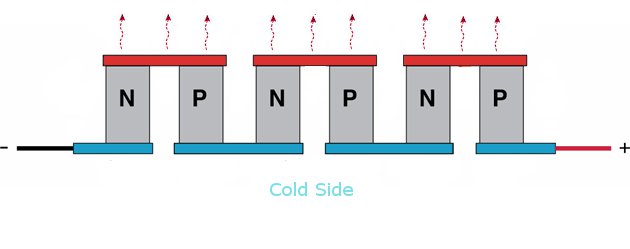
This makes DC power
Offline
Like button can go here
#37 2021-12-04 12:36:18
- SpaceNut
- Administrator
- From: New Hampshire
- Registered: 2004-07-22
- Posts: 29,894
Re: Thermal Energy Storage
With the need during winter I am looking at all forms of energy to retrieve from storage in any form.
https://mdpi-res.com/d_attachment/susta … -00191.pdf
A Comprehensive Review of Thermal Energy Storage
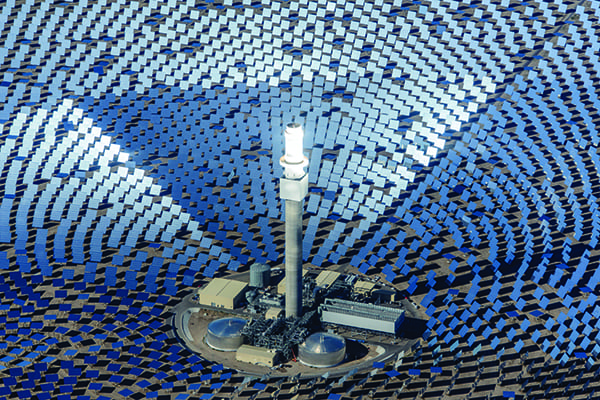

The trick is to pick a technology that is low cost to build with high reward in cost savings.
Offline
Like button can go here
#38 2021-12-05 13:16:21
- SpaceNut
- Administrator
- From: New Hampshire
- Registered: 2004-07-22
- Posts: 29,894
Re: Thermal Energy Storage
Temperature stratification is a term used to indicate teh layers of temperature that it may have from the top being the hotest to the bottom of the tank being the coldest.
Typical hook up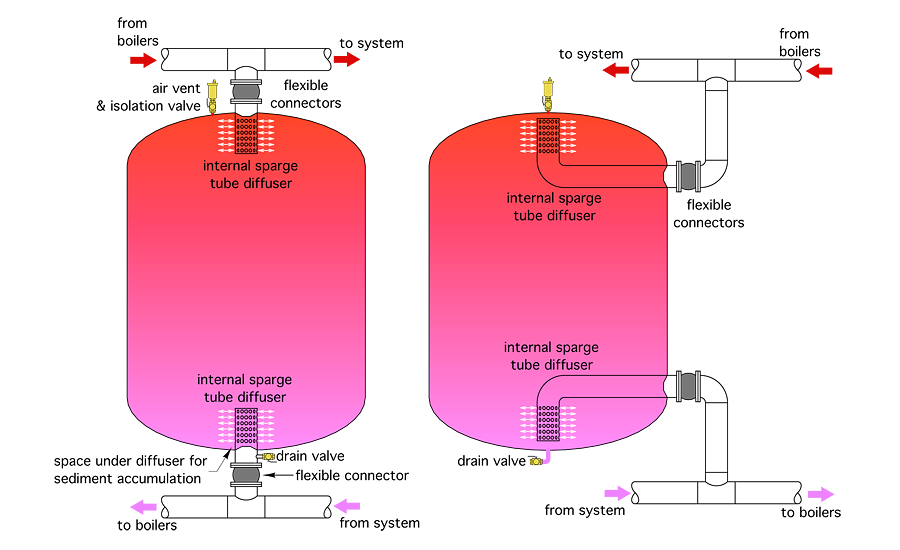
https://www.sciencedirect.com/science/a … 7X21000666
Design and investigation of single tank phase change thermal storage domestic hot water system
How zone use of the heat can be achieved
https://www.dntanks.com/what-we-do/ther … tes-works/
The https://www.builditsolar.com/ site has lots of projects that most can do
Check also out the https://www.homepower.com/ magazine that is now in archive for free to read about all of these types of solar...
Offline
Like button can go here
#39 2021-12-05 17:40:31
- kbd512
- Administrator
- Registered: 2015-01-02
- Posts: 8,349
Re: Thermal Energy Storage
SpaceNut,
Thanks for providing that document. I'm still reading through it, doing some calculations, and trying to price out different solar thermal plus storage energy solutions. I don't see photovoltaics and batteries as a long-term sustainable solution, which is not to say that they don't have their place, merely that current technology is impractical for implementing it on a global scale. There are too many unsolved problems left to work out. The average efficiency, losses, embodied energy, short lifespan, and lack of practical recycling are simply too great at a national or global scale. We need something that works, in general, for nearly everyone. Nuclear only works for a handful of highly industrialized countries.
Offline
Like button can go here
#40 2021-12-05 18:37:51
- SpaceNut
- Administrator
- From: New Hampshire
- Registered: 2004-07-22
- Posts: 29,894
Re: Thermal Energy Storage
Due the slope of the hillside and direction as well as the trees surrounding my property the ideal location is above the peak of the roof in order to gain the most energy from the sun during the hours which are either side of high noon with out tracking and set angle. Tracking while it adds cost gives back a greater amount than what is used by doing so.
That said a mix of technology will be needed from evacuated tubes, flat plate collectors, solar concentrating ect. not just PV panels as a result of the not so great of a location which drops in potential during the winters months when its needed most here. Even the use of rain water and wind must be considered for the short bursts of power that they can create to be save in net metering grid tie in.
Offline
Like button can go here
#41 2021-12-06 14:07:03
- tahanson43206
- Moderator
- Registered: 2018-04-27
- Posts: 23,415
Re: Thermal Energy Storage
This post is about molten Silicon used for space heating.
There are many space heaters on the market, for heating of unheated volumes such as outside garages, tents, barns and similar spaces.
The ones I remember from the US military in Germany used gasoline as a source of energy, and they had electricity available to operate a fan. Tents were heated with kerosene or diesel fueled stoves with stove pipes that vented through the ceiling.
In the current display of offerings, there are a great number of electric heaters, with and without fans. On the construction grade scale, there are electric blower systems with kerosene fuel. I assume the output is fed into a space to be heated with a flexible air conduit, and the exhaust from the system is (hopefully) carried away from the structure by prevailing winds.
This post is about something different ... the suggestion of kbd512 to consider molten Silicon caught my attention. I would ** think ** that a heating system could be designed to accept energy input over an extended period such as over 24 hours, and then delivered to a space that needs heat over a shorter period such as an hour.
How such a device would compare in cost is unknowable (by me for sure), but the rates I saw on offer range from $100 or so on the low end to $400 or so on the high end.
(th)
Offline
Like button can go here
#42 2021-12-06 20:11:04
- SpaceNut
- Administrator
- From: New Hampshire
- Registered: 2004-07-22
- Posts: 29,894
Re: Thermal Energy Storage
The real issue is the heat creation needs to not use electrical as made from coal, or other fossil fuels which does limit the possibilities for where the energy will come from.
Offline
Like button can go here
#43 2021-12-07 05:49:52
- Calliban
- Member
- From: Northern England, UK
- Registered: 2019-08-18
- Posts: 4,269
Re: Thermal Energy Storage
There are quite a lot of options for storing heat as an end use, depending upon the application. Sensible heat storage in the form of hot rock, is old technology now. It is the basis of storage heaters, which use off-peak electricity to heat an insulated container of quartz to high temperatures. Heat is then released into the room throughout the day. Water heaters can be configured in much the same way.
One option I looked into a few years back, was taking my house off grid and getting all power from a wind turbine. About half to two-thirds of all power produced would have been used to power storage heaters and a large hot water tank. This works well, because wind power provide most energy in autumn and winter. If large loads are brought online, the system would shed heating loads in their favour. A small DG would provide power when wind power was insufficient.
From a technical point of view, this system would have worked and I estimated that with some behavioural modifications, the DG would rarely be needed. We still had to have it, because the UK frequently experiences long depressions leading to a week or more of low wind speeds. Some years, I would have burned more diesel than others. But the average year, I wouldn't have needed more than a hundred litres.
The thing that killed the project was the high capital cost of a 10kW-peak wind turbine - about £80,000. And it would have required maintenance and eventually replacement. Even at the UKs high energy prices and high average wind speeds, the project simply didn't make sense on financial grounds. Nonetheless, it does suggest a probable least cost strategy for how wind powered economy might work in Europe and North America. You overbuild wind power relative to electricity demand and then use grid connected storage heaters and water heaters to absorb excess electricity in times on plenty. Size the heaters to store at least a few days worth of heat. During lulls, use open gas turbines to meet deficits in power supply. Because total generating capacity exceeds baseload demand by a high margin, the reality is that the load factor of the GTs will be low and gas consumption will be a small proportion of total energy consumption.
There are a number of problems with this strategy in Europe. Firstly, controlling large numbers of grid connected heaters would be problematic. Secondly, a heater of sufficient size would be bulky. Maybe molten silicon can help here? Thirdly, if electricity is used for heating, grid capacity must be adequate for peak load, which will greatly exceed existing baseload. That is not a cheap upgrade for any nation. Fourthly, natural gas supplies seem to be imploding very quickly. A system like this might get away with using a lot less than is presently used in most European countries for both heating and power generation. But it would need to be storable for long periods, ready to provide electric power at intervals that may be weeks apart. Wind farms of sufficient size would be a substantial fraction of land area of most European countries.
There are only so many you can fit in shallow coastal areas. Finally, we have cost. To make this work, we need two sets of powerplant instead of one; we need long-term gas storage, a transmission system with at least twice the capacity of the existing one and heating units whose activation can be controlled by grid operators. In totality, it is a tall order. And personal experience tells me it won't be cheap.
Last edited by Calliban (2021-12-07 06:05:47)
"Plan and prepare for every possibility, and you will never act. It is nobler to have courage as we stumble into half the things we fear than to analyse every possible obstacle and begin nothing. Great things are achieved by embracing great dangers."
Offline
Like button can go here
#44 2021-12-09 19:15:20
- SpaceNut
- Administrator
- From: New Hampshire
- Registered: 2004-07-22
- Posts: 29,894
Re: Thermal Energy Storage
The size of the rocks are important to the levels of heat curve that you are desiring from the capture of the heat that is coming into the system. Typical size is 3/4" to 2" size for the capture for the air circulating system to give off the heat over a period of time.
https://inspectapedia.com/Energy/Rock_B … Design.php
Of course smooth larger rocks can also be used in a design.
Of course with solar concentrated reflected energy the design would be altered versus other heat sources.
http://www.scienceasia.org/2010.36.n3/scias36_237.pdf
A rock fills based solar thermal energy storage system for housing

Changing the media type can also be done to improve the collection retention system as well
Zeolite thermal storage retains heat indefinitely, absorbs four times more heat than water
Offline
Like button can go here
#45 2021-12-12 22:59:34
- SpaceNut
- Administrator
- From: New Hampshire
- Registered: 2004-07-22
- Posts: 29,894
Re: Thermal Energy Storage
Offline
Like button can go here
#46 2021-12-23 10:51:35
- tahanson43206
- Moderator
- Registered: 2018-04-27
- Posts: 23,415
Re: Thermal Energy Storage
For SpaceNut re #44
This is a follow up to the post containing a reference to Zeolite ...
People also ask
How do you heat zeolite balls?
Because the heat is locked up in the chemical structure of the zeolite, the material never actually feels warm — which is why this is a “loss-free” storage method. These two processes can be kept separate — so first you charge the balls up with heat, and then later you can just add water (!) to release the heat.
Zeolite thermal storage retains heat indefinitely, absorbs ...www.extremetech.com/extreme/130523-zeolite-thermal-s…
See all results for this question
The above is a Google snippet set ... what I noticed was the claim that Zerolite can hold ? 4 times ? as much energy as water.
To release the energy, it appears the operator just adds water.
If you (or any forum member) runs across an application of this idea for heating for construction equipment or remote location power supply, I'd be interested.
I'm still looking for an affordable (by ** my ** budget) way of storing energy that can deliver 20 Amps at 120 VAC for one hour of continuous service.
The battery solutions I've found so far all exceed $1,000 and some are ** way ** above that level.
I am imagining a Zeolite container heated to capacity (whatever that is) and then a feed of water turning to steam that operates a small piston engine that drives a generator. That would be inefficient, but on the other hand, perhaps a machine to deliver 20 Amps at 120 VAC for an hour would not be expensive?
The expendable element in this scenario would be the fresh water used to make steam.
Input would be electric heating from the utility.
Update at 11:57 local time:
Dictionary zeolite
[ˈzēəˌlīt]
NOUN
any of a large group of minerals consisting of hydrated aluminosilicates of sodium, potassium, calcium, and barium. They can be readily dehydrated and rehydrated, and are used as cation exchangers and molecular sieves.
There is at least one company (located in Texas) that specializes in zerolite products. I picked up the impression that the characteristics of the mineral depend upon the deposit, and vary considerably.
*** Request for assistance .... The idea of thermal energy held "chemically" is new to me, and it may just be marketing hype ...
The exact wording (above) is: heat is locked up in the chemical structure of the zeolite
I wonder what those words mean?
Update at 12:08 local time:
https://news.mit.edu/2017/new-way-store … nergy-1117
Already, in this version, “the energy density is quite significant, even though we’re using a conventional phase-change material,” Han says. The material can store about 200 joules per gram, which she says is “very good for any organic phase-change material.” And already, “people have shown interest in using this for cooking in rural India,” she says. Such systems could also be used for drying agricultural crops or for space heating.
OK ... so there is a hint of something that might be turned into actual numbers ...
200 joules per gram is the performance of the research device. The goal is 10 Amps at 120 VAC for one hour.
That should translate into some number of joules, and ** that ** should extend to some number of grams.
For all I know (at this point) the result might weigh as much as RobertDyck's Large Ship.
(th)
Offline
Like button can go here
#47 2021-12-23 11:52:14
- SpaceNut
- Administrator
- From: New Hampshire
- Registered: 2004-07-22
- Posts: 29,894
Re: Thermal Energy Storage
One would think that steam turbines and its use would be easy but they are not something that seems to be readily available and seem unique to the application.
Today I picked up a Christmas gift for the son up north of the NH and its a gasoline generator for $529 at a local Lowe's its capable of powering 4000w peak with constant 3450w. I had to lift it into the back of the escape from the ground and since I weigh by far less I needed to lift one side the the lip of the hatch and then pick up the other with the legs to push it in. Sure it did not have any gas in it or I might not be able to do this.
phase-change material
https://en.wikipedia.org/wiki/Phase-change_material
So the issue for use is the energy type going in and the desired one coming back out means designing a device that can manage both conditions in the application
Offline
Like button can go here
#48 2021-12-23 12:57:27
- tahanson43206
- Moderator
- Registered: 2018-04-27
- Posts: 23,415
Re: Thermal Energy Storage
For SpaceNut re #47
There's a lot of energy in gasoline, so for the investment, the generator seems (to me for sure) like a good investment and it should be a much appreciated gift.
Here is more from Google ... I am still trying to understand what mass of material is needed if the capacity is 200 joules per gram.
energy - specific heat capacity - Dynamic Sciencehttp://www.dynamicscience.com.au › tester › chemistry
Water has one of the highest heat capacities with a value of 4.18J/g/°C. ... 23.5°C to 27.7°C calculate the energy content of the peanut in joules per gram.Heat of Fusion Example Problem - Melting Ice - ThoughtCohttps://www.thoughtco.com › Science › Chemistry
Nov 9, 2019 — Its units are usually Joules per gram (J/g) or calories per gram (cal/g). ... What is the heat in Joules required to melt 25 grams of ice?Specific heat, heat of fusion and vaporization example - Khan ...https://www.khanacademy.org › ... › States of matter
14:49
I might off a little bit on that number, but that digit is not that significant. Joules per gram Celsius times 200 ...
Khan Academy · Khan Academy · Aug 24, 2011Heat - Purdue Universityhttps://chemed.chem.purdue.edu › topicreview › heat
The calorie was defined so that the heat capacity of water was equal to one. ... Because there are 4.184 joules in a calorie, the specific heat of water is ...
The goal would be to know the mass of this (research) material that (reportedly) holds and then delivers 200 joules per gram, if the desired output is 20 Amps at 125 VAC for 1 hour.
I'm lost in the joules, calories, watts and kilowatts and all their variations, but assume there ** must ** be a number that will fall out.
(th)
Offline
Like button can go here
#49 2021-12-23 13:47:35
- SpaceNut
- Administrator
- From: New Hampshire
- Registered: 2004-07-22
- Posts: 29,894
Re: Thermal Energy Storage
First issues are unit of measurement to convert wattage to joules.
https://www.stouchlighting.com/blog/ele … w-kwh-lm/w
Watts are defined as 1 Watt = 1 Joule per second (1W = 1 J/s) which means that 1 kW = 1000 J/s. A Watt is the amount of energy (in Joules) that an electrical device (such as a light) is burning per second that it's running. So a 60W bulb is burning 60 Joules of energy every second you have it turned on
Since you want an hour that is 3600 seconds plus of time for the use of the tool at a source of 2,400 watts.
edit
error AC factor of 0.8 was missing to correct from DC to AC value so 2,400 w x 0.8 = 1,992 w ac
Water is 4.186 kJ/kg where the 200 joules per gram needs to be made to reflect kg or 1,000 grams but the joules are not correct
so we need to convert the energy we want of 2,400 j/s(w) * 3600 sec= 8,640,000 joules for the hour / 4,186 j = 2,064 kg of water
edit
so we need to convert the energy we want of 1,992 j/s(w) * 3600 sec= 6,912,000 joules for the hour / 4,186 j = 1,651 kg of water
Offline
Like button can go here
#50 2021-12-23 14:19:20
- kbd512
- Administrator
- Registered: 2015-01-02
- Posts: 8,349
Re: Thermal Energy Storage
SpaceNut,
In your Post #44, we're missing the number of cubic feet of molten Silicon for equivalent thermal energy storage.
Offline
Like button can go here
